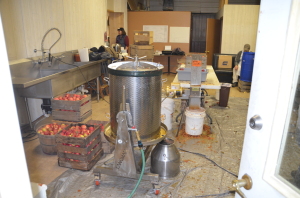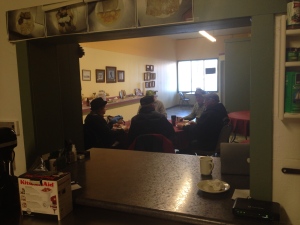In Clinton, MN, The Inadvertent Café is marking its successes one omelette—and one batch of sauerkraut—at a time.

By Brent Olson
There are four problems with food in a small town.
First, it’s hard to keep a grocery store open, because they can’t compete on price or variety with larger stores.
Second, people who are older or less mobile can have trouble obtaining good food, because they can’t travel long distances to shop.
Third, people who like interesting food can be out of luck. There just is a lack of quirky menus and cooks who care about innovation and creativity.
Fourth, people who want to be farmers but lack the opportunity or the interest in growing a couple thousand acres of corn and soybeans have trouble getting into the business.
Four problems, but one solution addresses them all.
And that’s where Big Stone Products, LLC, and The Inadvertent Café came from.
To make a long story a little shorter, a few years ago some local people, with help from the Land Stewardship Project, decided they wanted to rehab and return to use an old café in my hometown of Clinton. As my contribution I offered to put down a ceramic tile floor in the kitchen. As any of you who have remodeled old houses know, it turned into a … thing. I needed to put down a new subfloor, tear down a partition, if I’m going to walk the next day I can only work on my knees for about three hours at a time. As a result, I spent way too much time alone in a beat-up old building trying to figure out just what you could do with it.

Here was my conclusion. Open a café as a café for breakfast, just for a few hours a day, in order to cover the overhead — lights, utilities, that sort of thing. The rest of the time it would be a licensed commercial kitchen available for people who wanted to make value-added food.
The example I give is salsa. The salsa sold in our county comes from a thousand miles away, yet we grow all the ingredients for the best salsa right here. Why not make it here, provide some jobs, and do any number of other good things?
After no one else seemed to have any good ideas and the café had gone nearly a year without significant use or progress, I ran the idea past the Bush Foundation, and they agreed to let me spend $75,000 to find out if this was a good idea or not.
I may have condensed the story a little.
This has been under way for nearly two years. Since I couldn’t do the remodeling necessary and hire a cook and wait staff, I do the cooking and most of the table waiting myself. I can now make a terrific omelet and perhaps the best bread this side of Lyon. I still occasionally have crepe issues.
The café is open from 6:00 a.m. to 10:00 a.m. six days a week and is covering the overhead and sometimes making a little money. The value-added food portion has been a little slower, but this fall in one day we had a young woman use our equipment to can 70 quarts of tomatoes for her family in a short afternoon, a man put up 150 gallons of sauerkraut that will go on sale in January, and in the evening a group of people pressed 80 gallons of apple cider.
The apple cider is a good story. A young man from the area who graduated with a degree in philosophy from Concordia but who wants to live in Big Stone County has pressed, pasteurized, frozen, and sold over 500 gallons of organic apple cider, with another 100 bushels of apples to go. No one is making a living off value-added foods, not yet, but I believe we now have proof-of-concept.
This project is far from complete, and far from being considered an unqualified success, but I feel there are a few lessons I can pass on.
First, try and keep the stakes as low as possible. The café is in a building currently owned by the city. They rent it to me for $100 a month and probably would have taken less in order to keep the doors open. Utilities are about $160 a month, half of which is just so the customers can have free wi-fi. Without labor and groceries it costs less than a thousand dollars a month to operate. That lowers the stress level considerably. To match my costs, you need a lot of volunteer labor and a certain amount of luck.
Second, try and get a solid core of people willing to work. Talk is cheap, and the number of people willing to ante up and help is finite. I can’t tell you how many people have told me how much they love this project and how valuable it is to the community, but the number of people willing to wash dishes at 6:00 a.m. is considerably smaller.
Third, don’t get wedded to your own good ideas. I confess, I never saw the sauerkraut thing coming, but it was a perfect match in terms of timing and use of facilities. Get used to saying, “What the hell, let’s try it.”
Fourth, the regulatory people are not the enemy, even when it can feel like it. Public Health wants to help you keep from making people sick, so listen to what they say and don’t try to evade the rules.
Fifth, almost everything will cost more than you expect. I spent $12,000 hooking up the stove hood, (not purchasing it, just hooking it up). In 1926, when the building was built, the entire cost of construction was around $12,000. Stainless steel, NSF-approved equipment is expensive, and while used tables and racks are a bargain, refrigerators and freezers are not.
This story is not over. There are many avenues left to explore, and there are many communities trying the same thing. It will be fascinating to see how the story plays out.
Brent Olson lives in Clinton, where he manages the café, writes columns for several outlets, and is still working on perfecting his crepe. www.facebook.com/TheInadvertentCafe
